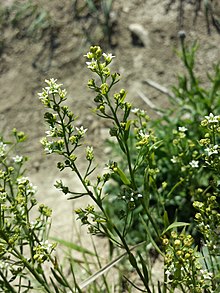Medium flax leaf
| Medium flax leaf | ||||||||||||
|---|---|---|---|---|---|---|---|---|---|---|---|---|

Medium flax leaf ( Thesium linophyllon ) |
||||||||||||
| Systematics | ||||||||||||
|
||||||||||||
| Scientific name | ||||||||||||
| Thesium linophyllon | ||||||||||||
| L. |
The middle flax leaf ( Thesium linophyllon ) is a species of the genus flax leaf ( Thesium ) within the sandalwood family (Santalaceae). It is common in Eurasia .
description
Vegetative characteristics
The middle flax leaf is an herbaceous plant that reaches heights of 10 to 30, rarely up to 40 centimeters. It has a loose grass growth due to its underground, yellowish-whitish foothills . The leaves have one to three nerves, rarely up to five, are 1 to 3, rarely 6 millimeters wide and light to yellow-green in color.
Generative characteristics
The inflorescence is a thyrse , the partial inflorescences are predominantly zymös . In each flower sitting three bracts: the cover page and two bracts . The petiole of the wrapper is recurrently fused with the flower stalk, so the leaf sits at the tip of the flower stalk, not at its base. The flowers are 4 to 6 millimeters in diameter. The perigone is five-lobed (rarely four-lobed). Flowering time is (May) June to July.
The fruit has a stem above the bract. When the fruit ripe, the perigone is rolled up to the bottom. This makes it appear significantly shorter than the fruit.
The number of chromosomes is 2n = 14 or 24.
ecology
The middle flax leaf is a geophyte . The middle flax leaf is a hemiparasite .
The pollination is done by bees . The scent is said to be decisive for attracting the bees, but to the human nose it appears so weak that it is hardly noticeable. The seeds are dispersed by ants .
The middle flax leaf is sometimes attacked by the rust fungus Puccinia thesii . The leaves are then crooked, the plant is yellow-green.
Occurrence
The middle flax leaf is common in Eurasia . It is a submeridional / montane to south-tempered floral element .
In Germany it occurs scattered in central and northern Bavaria , in southeastern Rhineland-Palatinate , in Thuringia , in southwestern Saxony-Anhalt and in Bremen , rarely in southern Bavaria , Baden-Württemberg , in southern and central Hesse , in northern and eastern Saxony-Anhalt , southeastern Lower Saxony and eastern Mecklenburg-Western Pomerania . It is extinct in Saxony. Overall, stocks are falling. In Germany it grows in dry grass and semi-patchy dry grass. It is in the subspecies Thesium linophyllon subsp. linophyllon a character species of the Adonido-Brachypodietum from the association Cirsio-Brachypodion, but the species also occurs in societies of the order Brometalia.
In Austria, the Mittlere Leinblatt occurs in Burgenland , in Vienna , Lower and Upper Austria , Styria and Tyrol ( Oberinntal ), the occurrence in Salzburg is questionable. It is classified as endangered. In the Alps and in the northern foothills of the Alps , it is considered endangered. It is extinct in Carinthia. It is common in the Pannonian region , otherwise it occurs sparsely or rarely. In Austria it grows in semi-arid and dry grasslands over limestone in the colline to montane altitude range .
In Central Europe it inhabits dry grasslands , rock bands and dunes . It rises in mountains at altitudes of over 1200 meters. The medium flax leaf thrives best on loose, sandy or stony soils that are very sunny.
Systematics
If the mountain flax leaf ( Thesium bavarum ) is placed as a subspecies to the middle flax leaf ( Thesium linophyllon ), it has two subspecies:
- Thesium linophyllon subsp. linophyllon
- Thesium linophyllon subsp. montanum (Schrad.) Čelak. (Syn .: Thesium bavarum cabinet ): It occurs only in Europe and Turkey.
Individual evidence
- ^ A b c d Manfred A. Fischer, Karl Oswald, Wolfgang Adler: excursion flora for Austria, Liechtenstein and South Tyrol . 3rd, improved edition. State of Upper Austria, Biology Center of the Upper Austrian State Museums, Linz 2008, ISBN 978-3-85474-187-9 .
- ↑ a b c d e Eckehart J. Jäger, Klaus Werner (ed.): Excursion flora from Germany . Founded by Werner Rothmaler. 10th edited edition. tape 4 : Vascular Plants: Critical Volume . Elsevier, Spektrum Akademischer Verlag, Munich / Heidelberg 2005, ISBN 3-8274-1496-2 .
- ↑ Dietmar Aichele, Heinz-Werner Schwegler: The flowering plants of Central Europe . 2nd Edition. tape 3 : Evening primrose plants to reddish plants . Franckh-Kosmos, Stuttgart 2000, ISBN 3-440-08048-X .
- ^ Erich Oberdorfer : Plant-sociological excursion flora for Germany and neighboring areas . With the collaboration of Angelika Schwabe and Theo Müller. 8th, heavily revised and expanded edition. Eugen Ulmer, Stuttgart (Hohenheim) 2001, ISBN 3-8001-3131-5 , pp. 323 .
- ↑ P. Uotila, 2011: Santalaceae . Datasheet Thesium In: Euro + Med Plantbase - the information resource for Euro-Mediterranean plant diversity.
Web links
- Medium flax leaf. In: FloraWeb.de.
- Distribution map for Germany. In: Floraweb .
- Thesium linophyllon L. In: Info Flora , the national data and information center for Swiss flora . Retrieved October 4, 2015.
- Thomas Meyer: Data sheet with identification key and photos at Flora-de: Flora von Deutschland (old name of the website: Flowers in Swabia ) Thesium linophyllon subsp. linophyllon
- Data sheet with photos.




